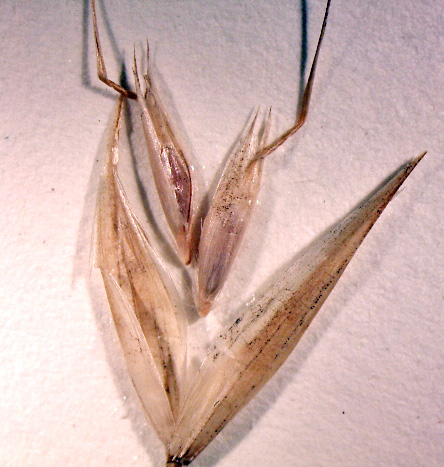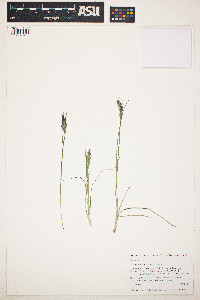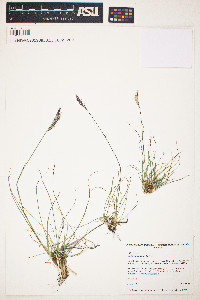|
Family: Poaceae
timber oatgrass
[ Danthonia canadensis B.R.Baum & Findlay, moreDanthonia intermedia var. cusickii T.A.William] |
Culms 10-50(70) cm, not disarticulating at maturity. Sheaths usually
glabrous; blades 5-10 cm long, 1-3.5 mm wide, glabrous or slightly pilose.
Inflorescences with (4)5-10 spikelets; branches stiff, appressed
or strongly ascending; lower branches with (1)2-3(5) spikelets; pedicels
on the lowest branch shorter than the spikelets. Spikelets 11-15(19)
mm. Calluses of middle florets longer than wide, concave abaxially; lemma
bodies 3-6 mm, glabrous over the back, densely pilose along the margins,
teeth 1.5-2.5 mm, acute to acuminate or aristate; awns 6.5-8 mm; anthers
usually tiny, sometimes to 4 mm. Caryopses (2)2.3-3 mm long, 0.7-1.1
mm wide. Cleistogenes rarely produced. 2n = 36, 98.
Danthonia intermedia grows in boreal and alpine meadows, open woods,
and on rocky slopes and northern plains. Its range extends from Kamchatka, Russia,
to North America, south along the cordillera, and east, through boreal and alpine
regions, to Quebec and Newfoundland and Labrador. Its primarily cleistogamous
reproduction has probably facilitated its establishment and spread through more
boreal and alpine habitats than other members of the genus.
Tzvelev (1976) treats the American plants as Danthonia intermedia Vasey
subsp. intermedia and the Russian plants, which have 2n = 18,
as Danthonia intermedia subsp. riabuschinskii (Kom.) Tzvelev.
Densely tufted, 2-5 dm, the culms slender, smooth; sheaths distally pilose, the lower often containing cleistogamous spikelets; blades flat or involute, 5-10 cm
נ1-3 mm, glabrous or sparsely pilose; infl contracted, 2-6 cm, the branches appressed, mostly shorter than their single terminal spikelet, or the lowest bearing 2 spikelets; glumes 10-16 נ3-4 mm, suffused with purple; lemmas 6.5-9 mm, of which a third is the setaceous teeth, glabrous on the back, sparsely pilose on the margins, chiefly below the middle; awn 6-10 mm; often apomictic, with abortive anthers; 2n=18, 36, ca 96. Meadows, bogs, and barrens; Lab. and Nf. to Alas., s. to Que., n. Mich., and Ariz.
Gleason, Henry A. & Cronquist, Arthur J. 1991. Manual of vascular plants of northeastern United States and adjacent Canada. lxxv + 910 pp.
©The New York Botanical Garden. All rights reserved. Used by permission. FNA 2007, Jepson Herbaria-Berkeley, Field Guide to Forest & Mtn. Plants of N AZ 2009, Ann. Checklist GCNP 1987 Common Name: timber oatgrass Duration: Perennial Nativity: Native Lifeform: Graminoid General: Widespread perennial bunchgrass with short, mostly basal leaves, and a narrow inflorescence 2-5 cm long. Vegetative: Blades 5-10 cm long, 1-3 mm wide, generally basal, glabrous except near ligule; stems 10-50 cm long, do not disarticuate at maturity; sheaths usually glabrous below the apex. Ecology: Found in forest and alpine meadows, bogs, open woodlands, northern plains,and rocky slopes at 5000-11,000 ft. (1500-3400 m); flowers June-August. Distribution: Found in all western states, South Dakota and Michigan. Notes: Because it grows early in the spring, this is a good grass for grazing. It reproduces primarily by self pollination, which likely helped it establish and spread more successfully than other Danthonia species. Is differentiated from D. unispicata by having 5-10 spikelets vs. 1-3 in D. unispicata and by having mature stems that do not disarticulate at the nodes. Its stiff lower inflorescence branches differentiate it from the flexible branches of D. parryi and D. californica. Ethnobotany: Unknown Etymology: Danthonia is named after Etienne Danthoine, a French botanist and agrostologist living in the 1700's. Editor: LKearsley, 2012 |




